Last Updated: January 26, 2025
Mexico is a coveted travel destination for many of its qualities. One of them is food. Thanks to fascinating traditions and history, Mexico’s diverse cuisine holds a spot on the UNESCO Intangible Cultural Heritage list. So, upon our arrival to Mexico City, a conglomeration of all things Mexican cuisine, it was clear that we had to organize a food tour.
Watch our Video!
You can find everything in Mexico City. It’s a culinary hub featuring the best eats from all over the country, allowing residents and visitors alike to fuel up and trace the history of this incredible valley all the way back to Mayan and Aztec times. The two most prized ingredients of pre-Hispanic Mexican cuisine – corn and chocolate – are greatly cherished in modern Mexican cuisine. With colonization, the influence of neighbors, and trade, new ingredients were introduced, and brand new dishes were invented to create the Mexican food we know and love today. And let us tell you, Mexican food is so much more than burritos and nachos!
We tracked down must try dishes in Mexico City at only the best eateries and embarked on a DIY food tour. Cramming the best Mexico City eats into one day and narrowing down to 10 selections was our biggest challenge, so forgive us if we digress a little. But with great gusto, we report to you our findings on where to eat in Mexico City and what to order. Prepare to appease your appetites and be left with delicious memories.
Map at Bottom of Post!

10 Best Foods in Mexico City

Tamales
There is no breakfast more quintessential to Mexico than a piping hot tamale – an ancient dish, one of the first ever made from corn. Each corn husk parcel envelopes an edible artifact made of masa, or corn flour, which is then stuffed with savory or sweet fillings and steamed. Typically, your tamale should be accompanied by atole, a hot and thick beverage made with masa, cinnamon, and sugar cane. We had ours at Los Vaporcitos, a small street side operation easily spotted by all the steam, hence the name! (Pro tip: They also make the best chicken sandwich!)

Tlacoyos

Tlacoyo is the tortilla’s voluptuous sister stuffed with beans or cheese. Oval shaped and thick, it needs the bulk for all the juicy toppings it carries. Made of corn masa, tlacoyos can be white or blue depending on the variety of corn. But we must admit that the blue tlacoyo looks extremely enticing when topped with green cactus – nopales, or yellow squash bloom – flor de calabaza.
Other varieties include cheese, beans, and pork rinds – chicharron. We purchased ours from an inconspicuous place in Mexico City’s historic center called Tlacoyos la Blanca. The reviews claimed their tlacoyos to be life changing, and we could not agree more!

Elotes and Esquites

Lush parks are bountiful in Mexico City, and when all of that walking calls for a snack, there are also plenty of street food vendors at the ready. Two popular street foods are elotes and esquites. Elotes are grilled corn on the cob topped with mayonnaise, chili powder, and cheese. And esquites are cooked corn kernels mixed with lime juice, chili powder, mayonnaise, and cheese. Basically, deconstructed elote served in a cup. We couldn’t believe our luck when we spotted the steam corn carts upon exiting the Anthropology Museum, the perfect snack to finish an extensive history tour.

We love elotes and esquites so much that no matter the city, when we arrive we head out in search of elotes and esquites. Bev loves elotes and John esquites.
Quesadillas with Huitlacoche

We are no strangers to quesadillas, though, in Mexico, they are different from what we are used to in the States. But huitlacoche? Never heard of it! A quick look at Google images did little to convince us to try it. As it turns out though, despite looking rather unappetizing, this ingredient is somewhat of a local delicacy akin to a truffle.
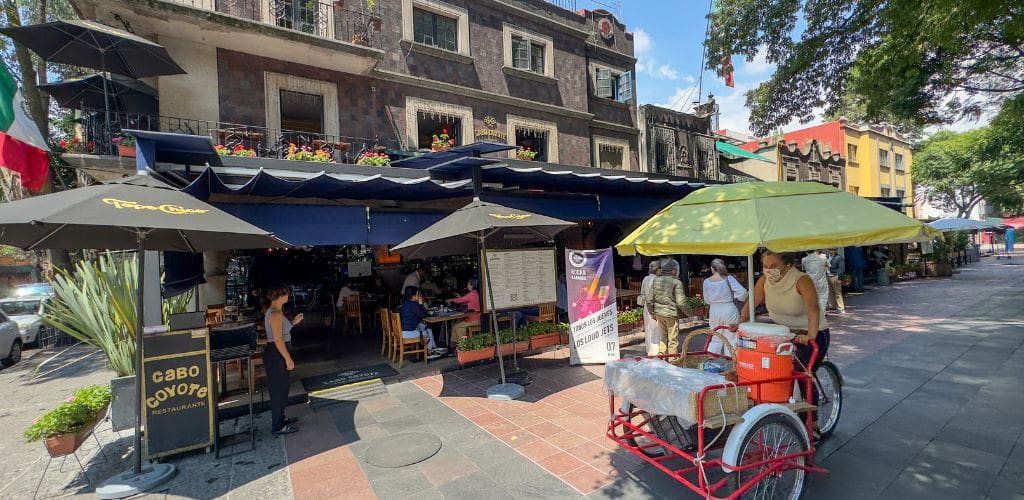
Essentially, we found out that huitlacoche is a corn fungus. While it’s commonly discarded in the U.S., in Mexico, it’s used in a handful of dishes – from quesadillas to inventive pizzas and fine dining restaurants. We had our run-in with huitlacoche quesadillas at Cabo Coyote next to the Jardin Centenario in the Coyoacán neighborhood. And let us tell you, huitlacoche definitely elevates the experience!

Churros

No food tour in Mexico City is complete without churros, and there is no better place to have them than at Churreria el Moro – fried dough heaven with 6 types of chocolate! This churreria first opened in 1935 and has grown into a local institution with 15 venues. Our servings were supersized, enough to satisfy both of us, and ordering hot chocolate for dipping your churros is a must. Make sure to get chocolate Mexicano to taste the historic elixir.
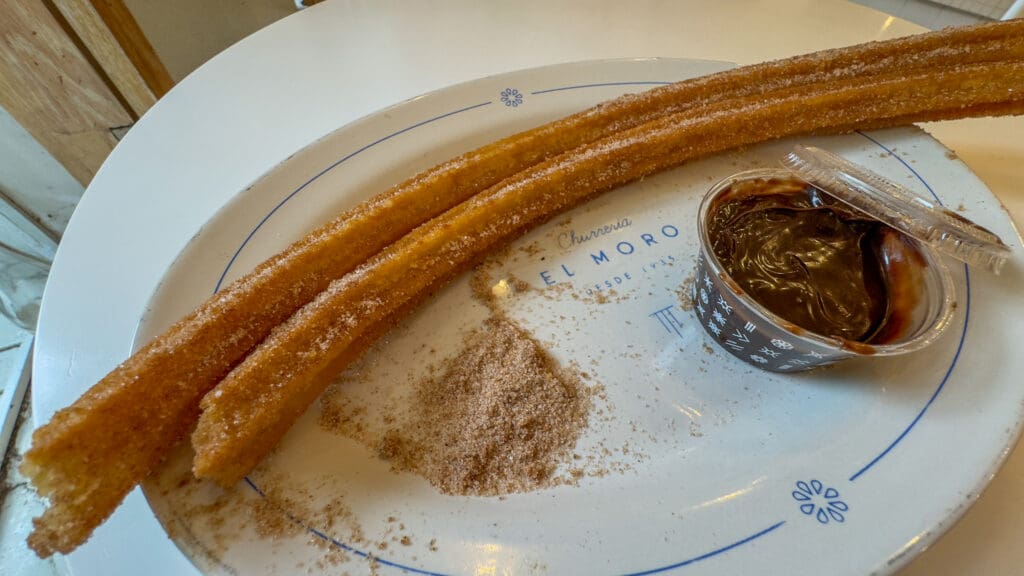
Pan Dulce

Pan dulce, or sweet bread, refers to all varieties of Mexican baked goods. That includes popular favorites like conchas, that look like sea shells, crumbly shortbread polvorones, crescent shaped bigotes, pan de muerto, and so much more. We loved visiting Mexican panaderias that were wrapped from floor to ceiling shelves brimming with sweet bread.
Our main objective was puerquitos – cute pig shaped cookies flavored with piloncillo, which is unrefined cane sugar commonly used in Mexico. We sought them out at the iconic Panaderia Rosetta, a unique bakery that combines French technique with indigenous Mexican ingredients. Paired with a coffee, it’s an exquisite afternoon snack!


Tacos al Pastor
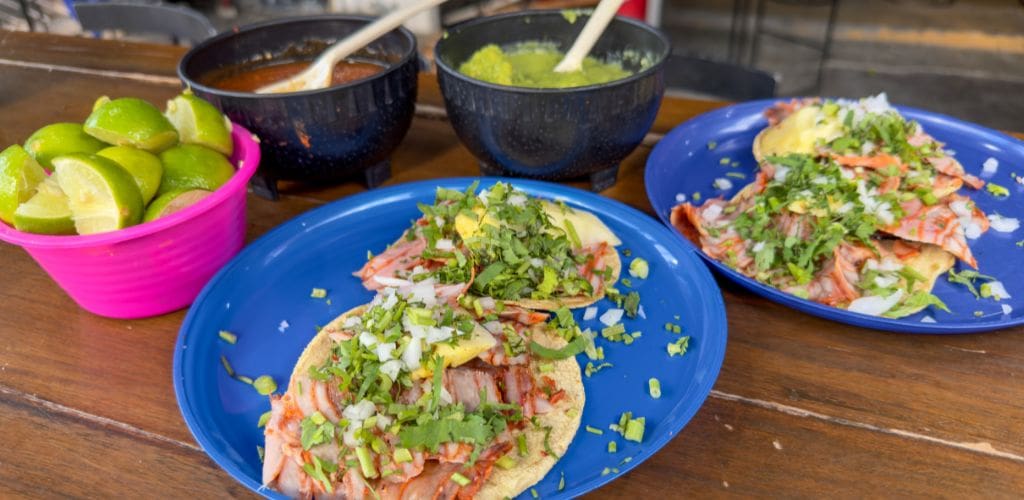
When considering what to eat in Mexico City, tacos undoubtedly come to mind. But did you know just how many varieties of tacos exist? The tortilla is merely an edible plate that holds all the juicy fillings disguised under unfamiliar-to-us names that distinguish the type of stuffing and method of preparation. Some Mexico City favorites are tacos de canasta, taco al carnitas, cochinita pibil, guisados, al pastor, de pescado. If you spot any of them on the menu, don’t think twice!
Tacos are the perfect meal for any time of the day, which is why they have their own designated section in this article. Tacos de canasta are usually had for breakfast, guisados are a lunchtime taco, and al pastor is usually a late night affair.

Hailing as “The King of Street Food in Mexico City”, it’s impossible to come to CDMX and not load up on succulent tacos al pastor. What turned into a quintessential dish is actually a product of immigration, said to have been influenced by the Lebanese lamb shawarma. The Mexican take uses the trompo method on pork marinated with chili and spices topped with pineapple. Tacos al pastor are frequently enjoyed as a late-night snack, but truth be told, they are perfect at any time of the day. We had ours at El Vilsito, a car repair shop by day and a taco stand by night made popular by the Netflix show Taco Chronicles.

Enchiladas

We thought this dish had some of the best elements of Mexican cuisine, all combined on one platter. Crispy stuffed corn tortillas, topped with gooey cheese and drenched in sauce, which occasionally happens to be mole. That’s the entré of our dreams, and the royal Aztecs thought so too. The stuffing of Mexican enchiladas varies and could even include huitlacoche, and so do the toppings, representative of the region. This is what sets Mexican enchiladas apart from TexMex ones that resort to beef. We had ours at Café de Tacuba, a restaurant founded in 1912. They have an entire menu section dedicated to enchiladas, including 10 varieties.

Pozole


Next on the menu was the ancient pre-Hispanic dish pozole. We enjoyed this ceremonial soup known for its use of corn, the sacred plant. The soup can be prepared with different meats, chicken, or pork. It can even be cooked in different colored broths – white, red, or green, depending on the salsa added. But corn kernels, the star ingredient, will always be present. Our soup was topped with heaps of fresh garnishes like avocado, chopped onions, radishes, and lettuce to add even more texture and flavor.
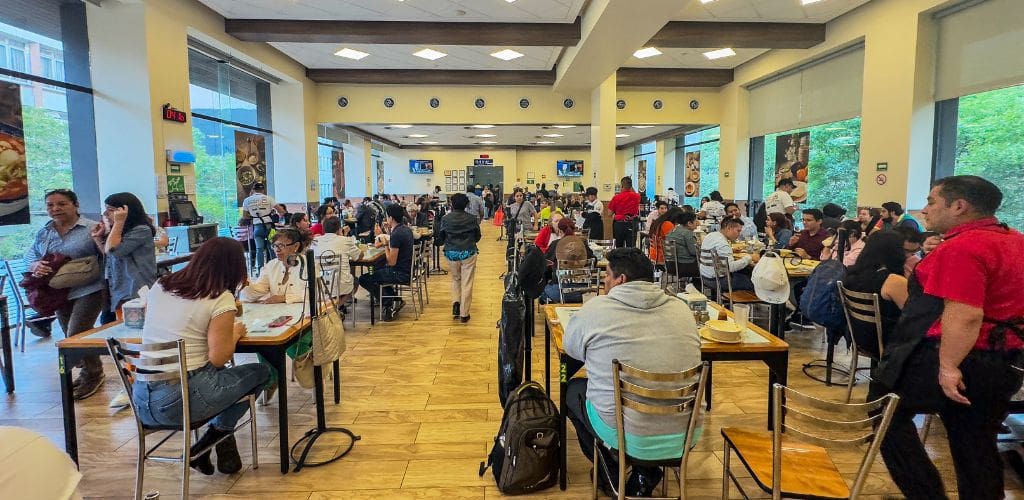
To have our introduction to pozole, we visited La Casa de Toño where this hearty soup is a specialty. This now popular chain restaurant has humble beginnings. It started as a street stand and grew into over 50 restaurants, but the dining experience is family style and down to earth. The persisting queue of locals was the first testament that we chose well. The second was our first slurp of the sacred stew.
Mole

There are many tales surrounding the origins of mole. Fundamentally, it is the result of blending various ingredients and can be traced to two Mexican states – Puebla and Oaxaca. Its preparation process is laborious and lengthy. Not only does it take a few days to grind up the ingredients to powder, but the cooking method requires constant stirring and attention to achieve the right level of thickness. Mole comes in many colors and can consist of up to 50 ingredients, chili being the essential one. The most common version is brown sauce served over meat to add a pungent flavor to the dish. The flavor profile will vary depending on the ingredients so to find one that suits your palate will take some tasting.

In Mexico City, the specialty is mole poblano, which is slightly bitter but rich thanks to chocolate. The other popular variety is mole almendrado, with a touch of sweetness thanks to almonds. We had an incredible experience at the upscale restaurant Pujol. This restaurant reinvents traditional Mexican cuisine and the mole is also aged. The reservations are not easy to come by, but in our books, eating mole that’s older than our grandkids is a once in a lifetime experience.
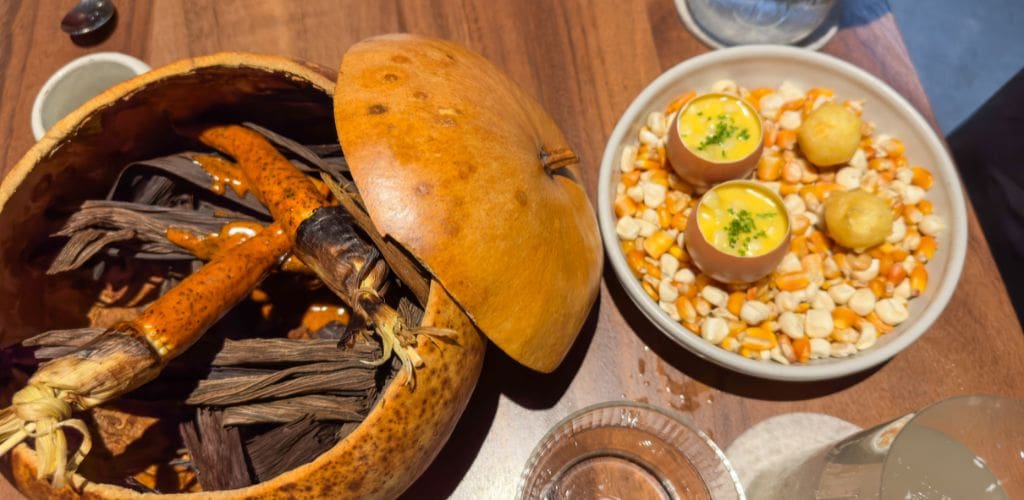
If you want authentic mole without frills, head to San Pedro Atocpan. We visited this community on the outskirts of Mexico that is known for producing and supplying mole to CDMX. And if your visit to Mexico City aligns with the National Mole Festival of San Pedro Atocpan held every October, then you absolutely must make the 2 hour journey!
Bebidas: Drinks
And to finish our DIY Mexico City food tour we have a little bonus for you. In case you are wondering what to wash down these dishes with, here are some options. For nonalcoholic drinks, you can’t beat an ice cold agua de sabor, or flavored water. Though a little underwhelming to the ear, these refreshments are incredibly addictive and come in a ton of different flavors. Our favorite was Jamaica – a sweet and tart hibiscus drink. We also loved horchata – a sweet and creamy rice milk and cinnamon beverage. Other fruity varieties often come with floating granules of chia. And for the alcoholic option, you can’t go wrong with a michelada. It is a mix of beer, lemon juice, tomato juice, and hot sauce.
And there we have it, the best of Mexico City eats and drinks. Buen provecho!
Let us know which of the 10 must try foods in Mexico City from our DIY tour were your favorite.
Mexico City Restaurant Location Map
HOW TO SAVE THIS MAP:
Each icon has embedded information in the map, so click to review. To the right of the title of the map, click the ⭐️ STAR to save to your Google Map Account. To view it on your computer or phone, open Google Maps, click the three lines on the upper left, select “Saved,” select “Maps,” and this map will be listed below.
Best Time to Visit Mexico City, Mexico
We have linked a great website to this button showing the weather for this location by the month. Clicking below will take you to Weather-and-Climate.com.


Leave a Reply